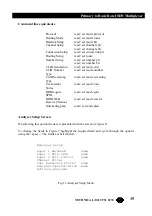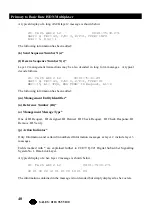
42
Primary to Basic Rate ISDN Multiplexer
SALES: 0118 965 5100
A typical display of a long ASCII layer 3 message is shown below.
23: TA Ch BRI 1 L3
00:01:75:30.271
PD= 65, LEN= 1, FLAG= Orig, CALL REF= 3, TYPE= SETUP
CALLING PARTY NUMBER:0 LENGTH= 7
TYPE= Unknown PLAN= ISDN/Telephony NUMBER= '234231'
CALLED PARTY NUMBER:0 LENGTH= 7
TYPE= Unknown PLAN= ISDN/Telephony NUMBER= '384020'
In the long ASCII message, decode all the information elements contained in the message are
decoded. Information elements are separated by a blank line, the information element name
together with relevant code set and length appears as a heading above each information
element decode and the decoded information is indented by 1 space.
For more information on * marked fields, messages and information elements refer to CCITT
Q.931 Digital Subscriber Signalling System No 1, Network Layer.
A typical display of a hex layer 3 message is shown below.
23: TA Ch BRI 2 L2
00:01:75:30.271
41 01 81 0D 18 01 89
The information contained in the message is not decoded but simply displayed as hex octets.
Analyser Commands
As soon as you enter analyser mode stored messages (if there are any) are displayed in
accordance with the analyser options selected. You may enter <esc> to exit analyser mode,
change the decode options and enter analyser mode again without losing any messages. The
options available are: -
(a) <m> - Manual Mode
The analyser enters manual mode. Automatic display of incoming messages is stopped and
the user can review the messages in the message buffer. Pressing M again will leave manual
mode.
(b) <home> or <b>- Go to First Message
Will display messages starting at the oldest message in the buffer. This command works in
manual and automatic modes.
(c) <end> or <e>- Go to Last Message
Will go to the last message in the buffer and display any new messages that arrive. This
command works in manual and automatic modes.
















































